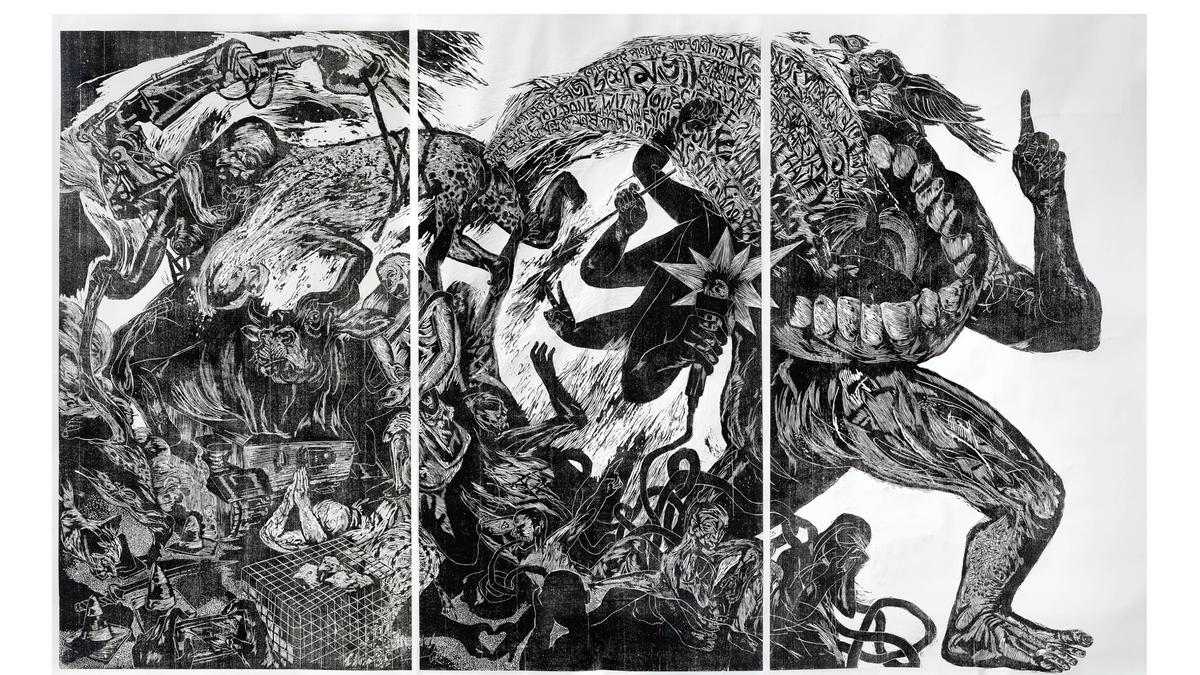
Emerging Palettes: A Hyderabad art exhibition platforms distinct themes and techniques
The Hindu
Emerging Palettes at Srishti art gallery, Hyderabad, platforms distinct themes and techniques
A striking feature of the 14th edition of Emerging Palettes, Hyderabad-based Srishti Art Gallery’s annual exhibition, is the experimentation with medium and the varied expressions of participating artists. They use woodcuts, installations, paintings and sculptures to comment on consumerism, gender sensitivity and urbanisation. Emerging Palettes, organised in collaboration with Goethe-Zentrum Hyderabad, features the works of 11 artists who completed their Masters in Arts within the last four years. The artists were chosen from over 200 applicants by a jury comprising Srishti’s owner, Lakshmi Nambiar, and artists Varunika Saraf and Amit Kumar Jain.
At the refurbished Srishti Art Gallery in Jubilee Hills that recently turned 20, a large (48” X 288”) three-panelled woodcut on paper artwork by Arpan Sadhukhan greets visitors near the entrance. Titled Return of Gargantua, the black-and-white work looks at economic disparity, a theme that the artist also explores through distorted figures in another series titled Dystopia (21 prints). He draws attention to the plight of middle-income households and contrasts it with the glitz and aspirational values sold by advertising and marketing companies.
On another wall are a set of smaller artworks with multiple panels in vibrant hues. Viewed from one end, the imagery is that of a wedding gathering. Viewed from another end, the image shows a bride being married to a dog, indicating the superstitious practice of the groom or the bride being married to an animal or an inanimate object to ward off the evil eye before the actual wedding. These artworks are a part of Siddharth Soni’s series titled This is Where I Come From. In another work that resembles a maze and titled Vortex, Siddharth shows how people are drawn to an idea and are invariably trapped within a belief system.
These exhibits are examples of how the artworks are conversation starters and aim to go beyond adorning pretty walls.
Elsewhere, one of Avijit Dutta’s (not to be confused with an established artist of the same name whose work has also been showcased at the India Art Fair) work features people with their faces covered by bags. In another work, he presents an outsider’s view of residential spaces with grilled windows that he metaphorically equates to decorated prisons. In Kolkata’s industrial areas near the Howrah bridge, he depicts the bond between the labour workforce and the materials they use and, in turn, highlights rapid urbanisation and diminishing presence of nature.
Debashruti Aich’s art is a coming together of techniques and media — watercolour on parchment paper and embroidery on organza silk. She studies the feminine form, in one work mirroring the chaos and complexities of adolescence and in another, depicting how women eventually get comfortable in their skin.
Deparna Saha’s installation is a collection of smaller images on handmade paper, strung together on a black thread akin to photographs that have just been developed and allowed to dry in a dark room. The artist explores family ties, food and culture.











